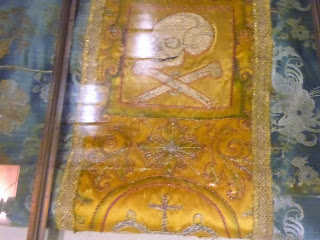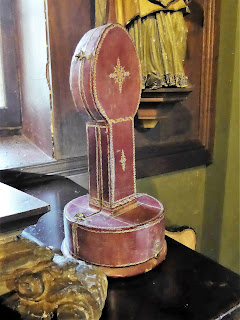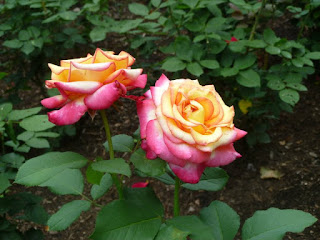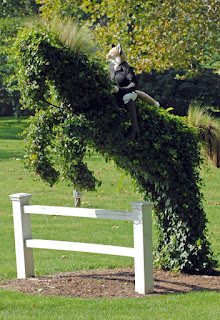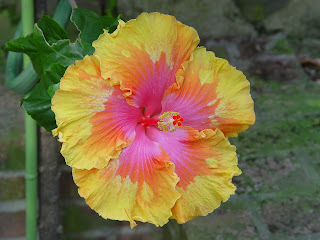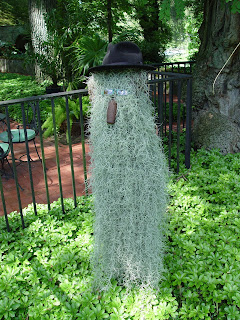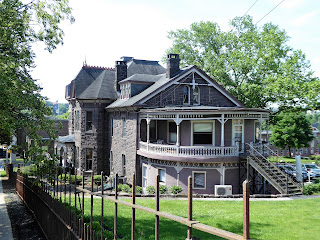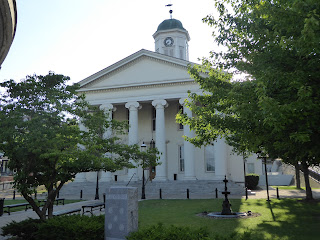 |
| The Concord Point Lighthouse dates back to 1827 |
Some things remain a mystery, like why weathermen in the Harrisburg area appear to be fixated on a town that takes two hours to reach by car. For as far back as I can remember, local prognosticators have dutifully reported on the temperatures in Havre de Grace, Maryland, which makes little sense to me. After all, Philadelphia and West Chester are within striking distance, yet we rarely hear about the weather there.
My curiosity eventually got the best of me and I began researching the little town of less than 15,000. I learned that in 2014 the area was named by
Smithsonian Magazine as one of the top 20 best small towns to visit, so I decided to travel there earlier in the month to learn more about what makes it so special.
I now understand why the place is so highly regarded, although I'm still a bit flummoxed as to why local weathermen are so entranced, other than the fact that it always seems warmer there than in my neck of the woods.
In my next blog post, I'll share more about this scenic area situated at the mouth of the Susquehanna River and the head of the Chesapeake Bay, but for now, I'll share a little more about three historic B&Bs, which are all located conveniently near shops, restaurants, and other destinations.
The Vandiver Inn
Located at 301 S. Union Avenue, the Vandiver Inn is known as a premier wedding destination, so chances are you may see a bride or two during your visit.
The mansion dates back to 1886 and is named after Murray Vandiver, who served as Secretary and Treasurer of Maryland and as Mayor of Havre de Grace.Vandiver built the large Victorian "cottage" as a present for his wife, so it seems quite fitting that today it is a popular wedding venue.
 |
| The Vandiver Inn |
For a time, the house served as an apartment complex, but in the 1980s it was restored to its former glory. Stained glass windows which had previously been removed and sold were amazingly tracked down by the new owners and returned to their proper place.
 |
| An attractive bronze lights the way to the rooms upstairs. |
Guests can choose from among three houses when staying at the Vandiver Inn. We spent the weekend in the comfortable Cockburn Room in the Kent House located right next door to the main mansion. The attractive room features a sitting area, a private entrance, and a porch overlooking the lawn. Breakfast is served at the main house each morning and can be enjoyed on the lovely and spacious front porch during warmer weather.
 |
| A lovely setting for sipping on a large cuppa Joe. |
 |
| The sitting room at the Vandiver Inn |
 |
| Guests help themselves to ala carte breakfast items here. Our hot morning dish was crab quiche. |
 |
| The inside of the Cockburn Room |
 |
| The sitting area of the Cockburn Room. |
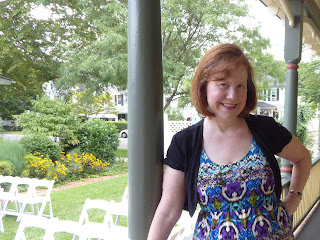 |
| What's happening behind me? We could have had a birds-eye view to an "I-Do" or two, but we decided to allow them their privacy. |
The Spencer-Silver Mansion
The Spencer-Silver Mansion dates back to 1896 and is known as one of the largest historic houses in Havre de Grace built as a private residence. Crafted of granite from nearby Port Deposit, the structure is recognized as the only High Victorian stone mansion in the city.
 |
| The Spencer Silver Mansion |
The house was constructed for John Spencer, a merchant and foundry owner and was later purchased by Charles Silver, the owner of a local cannery.
At one point in time, according to owner Carol Nemeth, a group of doctors joined together with the intention of gutting the stunning structure to make way for a clinic. Luckily, Nemeth was willing to pivot from her occupation in International Banking to proprietor of a bed and breakfast.She used her passion for historical preservation to restore the home to its former glory and has been lovingly caring for the property for the past 29 years.
The main house consists of four guest rooms furnished with Victorian antiques. A two-story cottage tucked away behind the mansion features a whirlpool bath, a spiral staircase, a living room with a working fireplace and a queen-sized bed.
 |
| Sitting room of the Spencer-Silver Mansion |
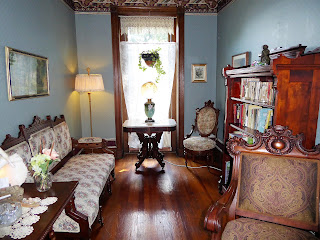 |
| Second-floor sitting area of the Spencer-Silver Mansion |
Antique lovers will find something of interest in every turn of the head at La Cle D'or (Key of Gold) Guesthouse located at 226 North Union Avenue.
The home dates back to 1868 and was once the home to Henry Harrison Hopkins, a pharmacist who built the structure in the Second Empire Style. The Maryland Inventory of Historic Properties describes the home as having "an eclectic, even eccentric style that became popular after the Civil War."
Owner Ron Browning is always ready, willing and available to discuss the provenance of each antique with an encyclopedic knowledge and guests are encouraged to inquire about the pieces, many of which are for sale.
The former history teacher owns furniture that dates back to the 1700s, Delft pottery dating back to the 1600s, an 1800's "flow blue" china collection, documents signed by Lafayette and Louis XIV and an authentic Renoir, to name just a few of the impressive items on display.
 |
| A front view of La Cle D'or Guesthouse |
 |
| A lion guards the front of the La Cle D'or Guesthouse |
 |
| Living room of La Cle D'or |
 |
| Alcove at La Cle D'or |
 |
| Dining room at La Cle D'or |
 |
| Antiques at La Cle D'or |
 |
| The Lapis Lazuli room at La Cle D'or |
 |
| The Russian Room at La Cle D'or |
 |
| Back patio at La Cle D'or |
These interesting, excellent and comfortable lodging options are just a few that are available for your stay in Havre de Grace. For those who enjoy architecture and history, they also have the added advantage of being located on the
Lafayette Trail.
Many thanks to Tyler Buck for taking the time to show me around the town during my stay and for literally opening the doors to these beautiful venues.
Next Up: Exploring Havre de Grace



































